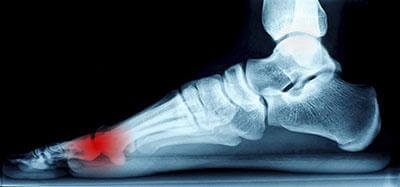
What is a Neuroma?
A neuroma is a benign thickening of nerve tissue and the most common in the foot is a Morton’s neuroma, which occurs between the third and fourth toes. With chronic irritation, the nerve thickens and enlarges. The mechanism of injury of the nerve is due to entrapment and repetitive injury of the nerve.
What causes a Neuroma?
The incidence of interdigital neuromas is much greater in females than males because they typically wear shoes with a high heel and narrow toe box, which is a major cause of the disease process. Anything that causes compression or irritation of the nerve can lead to developing a neuroma. Activities that involve irritation to the bottom of the foot such as walking or running can contribute to the development of a neuroma as well as any trauma to the foot. Patients with foot deformities such as bunions, hammertoes and flatfeet are at a higher risk of developing a neuroma.
Symptoms of a Neuroma
Patients commonly report pain at the ball of the foot. The pain is usually accompanied by a burning and tingling sensation that shoots into the involved toes. As the injury progresses patients may feel numbness. Patients may describe the feeling of something moving around or a wrinkle in the sock on the bottom of the foot. Symptoms are often relieved by stopping the aggravating activity, removing the shoe and massaging the foot. The symptoms become more intense and last longer as the neuroma enlarges and causes permanent damage to the nerve.
Diagnosis of a Neuroma
Diagnosis is best made by a thorough history and physical examination. A helpful test is to squeeze the foot from side to side while touching the web space, which may result in a click or grinding feeling. Weight-bearing x-rays may be helpful to rule out a bone related problem such as a stress fracture. An MRI can also be ordered to diagnose a neuroma.
Treatment of a Neuroma
Non-surgical treatment is often successful. Neuroma symptoms can be relieved by wearing wider shoes, shoes with stiffer soles and lower heels. A metatarsal pad can alleviate excessive pressure under the metatarsal heads. Ice therapy and anti-inflammatory medications (NSAID’s) can be used to decrease pain and inflammation. Custom molded orthotics is important and help provide the support needed to reduce the pressure and compression that is placed on the nerve. Dr. Fihman will also recommend corticosteroid injections to reduce any inflammation and break down scar tissue around the nerve. Sometimes multiple injections are needed. In more severe and chronic cases in which conservative treatment has failed, another treatment option is alcohol sclerosis injections. This injection deadens the nerve causing less pain because the nerve is no longer signaling.
Surgical treatment is indicated when nonsurgical treatment failed. The most common surgical treatment is excision of the nerve. The procedure removes the nerve from the area of the metatarsal heads. Surgery will decrease or completely remove the pain.
